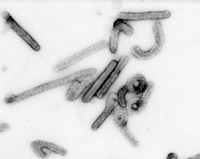 username@email.com
username@email.com
In this lesson, you will review the characteristics and types of viruses.
Viruses are not part of any taxonomy, and with good reason. It is not at all clear that viruses are living things. They are certainly not cells, as they cannot perform any functions on their own. For all intents and purposes, outside a host a virus is as dead as a rock. It has no metabolism, respiration, motility, reproduction, or any other function that defines a living organism.
Viruses are minute snippets of DNA or RNA wrapped in a protein coat. Receptors on the protein coat are specific for the type of cell the virus infects. It is only when a virus infects its target cell that it comes to life. The virus’s sole purpose is to enter a cell or inject its DNA into a cell, hijack its reproductive process, and force it to replicate the virus’s DNA. Some viruses destroy the cells they infect, others do not. There are viruses adapted to infect just about every type of cell there is, including bacteria. These viruses are called bacteriophages.

Marburg Virus
Different viruses have different modes of transmission to a host, whether through the air, through contaminated food or water, or through direct contact. Once it enters a host, the virus makes its way to its target cell. The receptor on the virus coat (the key) mimics the receptor on the cell surface (the lock), allowing the virus to attach to the cell. Then the virus enters the cell or injects its DNA into the cell. Viral proteins have various nefarious ways to take over a cell’s reproductive process. Some viral proteins kick a resting cell into reproductive mode; others force the cell to reproduce only viral DNA. In some cases, as with some enteric adenoviruses (intestinal viruses), a single infected cell may churn out hundreds of thousands of newly formed viruses in one day.
Viruses are also amazingly clever at avoiding the onslaughts of the immune system. Many viruses are adept at masking or shutting down cellular production of interferon, which calls the immune system to arms. Viruses’ evasion tactics are endlessly inventive. Hepatitis B virus has its host cell create and eject empty decoy viral envelopes, which are attacked by the immune system while countless stuffed viral envelopes escape.
Retroviruses, such as HIV, are a large family of viruses that have single-stranded RNA instead of double-stranded DNA as its genetic material. It has a unique characteristic of producing a reverse transcriptase enzyme used to translate its RNA to become part of its host cell’s DNA. This allows many retrovirus copies to be made within the host cell since every time the cell replicates its DNA, the viral DNA is also copied. After a period of replicating in cells, the HIV infects helper T-cells, whose role is to activate virus-specific T- and B-cells. Thousands of HIV are replicated in helper T-cells, which then die and cannot activate the immune system. So the immune system churns out more helper T-cells, which are infected, make more HIV, and die. In short, the more helper T-cells the immune system makes to jump-start an attack, the more virulent the disease becomes. Additionally, retroviruses cause many naturally occurring cancers in vertebrates.
Prions are infinitesimal bits of proteins that have somehow been altered from their normal configuration. Mad cow disease (bovine spongiform encephalopathy, or BSE) is caused by prions in the brain that are able to change normal brain proteins into prions. In BSE (and similarly in Creutzfeld-Jakob disease (CJDv) in humans), normal brain proteins that can be lysed and removed by enzymes are transformed into prions that are invulnerable to the enzymes. The abnormal proteins accumulate in the brain and create holes. This prion disease is invariably fatal. Scientists have been unable to find any trace of genetic material (either DNA or RNA) in prions or in infected brains. Prions also do not elicit an immune response from the body. Prions are so strange that their existence and behavior undermine biology as we know it.
How do viruses get to perform the one function they have in common with living organisms?
The correct answer is C. Viruses’ only function is to reproduce their genetic material, which can be accomplished only when they get an infected cell’s reproductive process to replicate their DNA for them. Locomotion refers to an organism’s expending energy to move on its own. Viruses cannot move on their own and have no energy of their own to expend, so A is not correct. Viruses never metabolize fuel; they only hijack cells’ reproductive apparatus, so B is incorrect. Living cells produce interferon to signal infection to the immune system, so D is not correct.